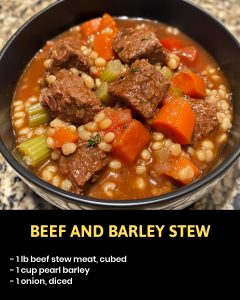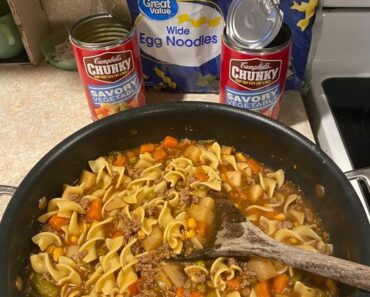
Hearty Beef and Barley Stew
There’s nothing quite like a comforting bowl of beef and barley stew to warm you up on a chilly evening. This classic recipe is rich, filling, and packed with the robust flavors of tender beef, wholesome barley, and a blend of aromatic vegetables. The slow simmering time allows the flavors to meld together, resulting in a thick, satisfying stew with a deep, savory taste. This is the ultimate comfort food that’s easy to make, nutritious, and incredibly satisfying.
Ingredients Overview
- Beef Stew Meat: Use cubed stew meat for the best results. It becomes tender and flavorful after a long, slow cook. You can use chuck roast or any other tough cut of meat that benefits from simmering.
- Pearl Barley: A hearty grain that thickens the stew and provides a delightful chewy texture. Pearl barley also makes the stew more filling, adding fiber and nutrients.
- Onion: Adds sweetness and depth to the stew as it cooks down, enhancing the flavor of the beef and vegetables.
- Carrots: They bring a touch of sweetness and a pop of color, balancing the savory elements of the stew.
- Celery: Adds an aromatic, earthy flavor that complements the beef and other vegetables beautifully.
- Garlic: A couple of minced garlic cloves add a subtle but crucial depth of flavor, enhancing the overall taste of the stew.
- Beef Broth: Forms the base of the stew, providing a rich, savory background. A good quality broth makes a big difference in flavor.
- Diced Tomatoes: A can of diced tomatoes adds acidity and a hint of sweetness, balancing the richness of the beef and broth.
- Thyme: This earthy herb complements the flavors of beef and barley wonderfully. Fresh thyme is great, but dried works well too.
- Salt & Pepper: Adjust these to taste, enhancing the flavors of the other ingredients.
Step-by-Step Cooking Instructions
Step 1: Brown the Beef
In a large pot, heat a drizzle of oil over medium-high heat. Add the cubed beef stew meat in a single layer and brown on all sides, about 5-7 minutes. This browning step helps develop a rich flavor base for the stew, as the caramelized bits add depth.
Step 2: Sauté the Vegetables
After the beef is browned, add the diced onion, sliced carrots, chopped celery, and minced garlic to the pot. Cook for about 5 minutes, stirring occasionally, until the vegetables are softened and the onions are translucent.
Step 3: Add the Barley and Seasonings
Stir in the pearl barley, followed by the beef broth, diced tomatoes, and thyme. Season with salt and pepper to taste. This combination of ingredients forms the hearty base of the stew.
Step 4: Bring to a Boil and Simmer
Increase the heat to bring the stew to a boil, then immediately reduce it to low. Cover and simmer for 1-2 hours, stirring occasionally. This allows the beef to tenderize and the barley to fully absorb the broth, thickening the stew. Check periodically, adjusting the seasoning as needed.
Step 5: Serve and Enjoy
Once the beef is tender and the barley is fully cooked, the stew is ready to serve. Ladle into bowls and garnish with fresh herbs like parsley or a sprinkle of black pepper if desired. Enjoy warm!
Tips for a Perfect Beef and Barley Stew
- Sear the Beef Well: Take the time to get a nice brown crust on the beef. This step adds a depth of flavor that elevates the stew.
- Use Good-Quality Broth: Opt for low-sodium beef broth if possible, so you can better control the salt level and let the other flavors shine.
- Rinse the Barley: Rinse the barley under cold water to remove any excess starch, which helps keep the stew from getting too thick.
- Add Extra Vegetables: Feel free to add potatoes, mushrooms, or parsnips for more texture and flavor.
- Simmer for Flavor: The longer the stew simmers, the better the flavors develop. If you have the time, let it cook for the full two hours.
- Adjust Consistency: If the stew is too thick, add a little more beef broth. For a thicker texture, let it simmer uncovered for the last 15-20 minutes.
- Taste as You Go: Season at each step—while browning the beef, after adding the broth, and before serving.
- Consider Fresh Herbs: Fresh thyme, rosemary, or parsley added just before serving gives the stew a bright, fresh flavor.
- Acidity Balance: If you want to add brightness, a dash of Worcestershire sauce or a splash of red wine vinegar can bring out the richness.
Storage and Reheating Tips
- Refrigeration: Store leftovers in an airtight container in the refrigerator for up to 4 days. The flavors continue to deepen, making the stew even better the next day.
- Freezing: Beef and barley stew freezes very well. Allow it to cool completely, then store in freezer-safe containers for up to 3 months. Thaw overnight in the refrigerator before reheating.
- Reheating: Reheat on the stove over low heat, stirring occasionally. Add a splash of broth or water if the stew has thickened too much during storage.
Frequently Asked Questions (FAQs)
Q1: Can I use a different type of meat?
Yes, lamb or pork work well, though the flavor profile will change slightly.
Q2: Can I make this stew in a slow cooker?
Yes! Sear the beef first, then add all ingredients to the slow cooker on low for 6-8 hours.
Q3: Can I use quick-cooking barley?
Yes, but reduce the simmering time as quick-cooking barley cooks faster.
Q4: Can I make this in an Instant Pot?
Yes! Sauté the beef and vegetables, then add the remaining ingredients and cook on high pressure for 25-30 minutes.
Q5: What can I substitute for barley?
Farro, quinoa, or brown rice work as substitutes, though each brings a unique texture.
Q6: Can I use fresh tomatoes instead of canned?
Yes, substitute with about 2 cups of chopped fresh tomatoes.
Q7: Can I add wine to this recipe?
Absolutely! A splash of red wine added before the broth can deepen the flavor.
Q8: How do I make it gluten-free?
Substitute barley with quinoa or rice for a gluten-free option.
Q9: Can I skip the tomatoes?
Yes, but the tomatoes add acidity, which balances the stew’s richness.
Q10: What herbs work well in this stew?
Rosemary, bay leaves, or fresh parsley all complement the beef and barley.
Q11: How can I make it thicker?
Simmer uncovered for the last 15 minutes, or mash some of the vegetables with a fork.
Q12: Can I use bone broth?
Yes, it will add more richness and nutritional benefits.
Q13: Can I freeze leftovers with barley?
Yes, barley holds up well in the freezer, making it perfect for meal prep.
Q14: How can I add extra protein?
Add more beef or try adding beans like cannellini or kidney beans.
Q15: What can I serve with this stew?
Serve with crusty bread, a green salad, or over mashed potatoes.
Q16: Can I add potatoes to this stew?
Yes, cubed potatoes make the stew even heartier.
Q17: How do I prevent the barley from becoming mushy?
Check the stew as it cooks and avoid overcooking the barley.
Q18: Can I use water instead of broth?
Yes, but broth adds much more flavor. If using water, add a bouillon cube.
Q19: Can I use frozen vegetables?
Yes, add frozen carrots, peas, or corn during the last 20 minutes of simmering.
Q20: How can I make this stew richer?
Add a dollop of tomato paste, a splash of Worcestershire sauce, or a pat of butter.
20 Secrets for Culinary Perfection with Beef and Barley Stew
- Brown the Beef First: This adds a delicious caramelized flavor.
- Deglaze the Pot: After browning, deglaze with a bit of broth or wine to lift any flavorful bits.
- Use Fresh Herbs: Adding fresh thyme or parsley at the end makes the flavors pop.
- Go Low and Slow: Simmering the stew for a longer time enhances its depth.
- Add the Barley Later: If you’re not eating it all at once, add barley later to avoid mushiness.
- Don’t Over-Stir: Stir occasionally, but too much can break down the barley.
- Experiment with Mushrooms: Sauté mushrooms and add them for a savory umami flavor.
- Try Different Cuts of Beef: Chuck roast or brisket add even more flavor.
- Balance with Acidity: A splash of vinegar or Worcestershire sauce before serving brightens the dish.




















